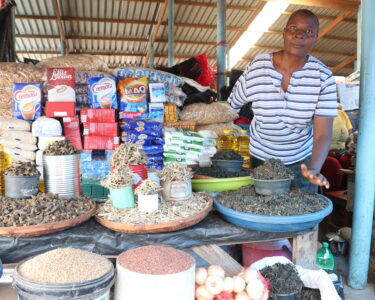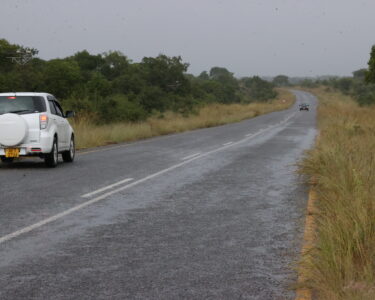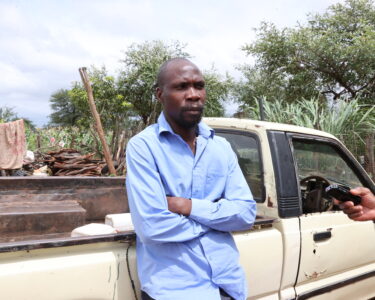Despite its lofty position as Zimbabwe’s No.2 tourist destination, Great Zimbabwe has never had an outside beauty that befits its status. Its visitor facilities have always been poor, leading Lovemore Mandima, the National Museums and Monuments of Zimbabwe’s regional director for the Southern Region, to say: “Currently what you see at Great Zimbabwe may make you wonder if Great Zimbabwe is really a world heritage site in terms of infrastructure.” All that is going to change when a major facelift begins in the next few months. Baffour Ankomah reports.
Sixty-five years after the controversy over who built Great Zimbabwe was put to a final rest, Zimbabwe’s number two tourist destination will get the facelift it rightly deserves in 2023. A Euro3 million grant from the French development agency, the Agence Française de Développement (AFD), given through the French embassy in Harare, will ensure that the decrepit visitor facilities at Great Zimbabwe become a thing of the past.
The refurbishment is another of the projects that will enhance the prestige of the Masvingo Province – projects initiated either directly by the Second Republic or have come through the influence of the Second Republic through private hands.
Built by the Shona ancestors, Great Zimbabwe dazzled the colonial white settlers, so much that for a long time white opinion in Rhodesia and South Africa could not accept that it was built by Africans. What became “the Zimbabwe controversy” of the colonial days revolved around the idea that foreigners, and not Africans, built Great Zimbabwe.
The root of this thinking, in fact, lay with Karl Gottlieb Mauch, the German explorer and geographer of Africa, who was the first European to see the Great Zimbabwe ruins in 1871. He went back home to publicise the ruins but in the process, he added myths to the effect that Great Zimbabwe had been built by King Solomon and the Queen of Sheba.
In 1891, James Theodore Bent, an English explorer and archaeologist, was sponsored by the Royal Geographical Society, the British South Africa Company and the British Association for the Advancement of Science to study the ruins. He, too, endorsed the idea that Africans did not build it. He saw Great Zimbabwe as a by-product of Arab and Phoenician commercial enterprise in the Indian Ocean and adjacent lands.
Then in 1902, Richard Nicklin Hall, a British journalist, was appointed the curator of Great Zimbabwe and while popularising the ruins, he made matters even worse by claiming that the ruins were of “high antiquity and South Arabian origin” (which was totally wrong). Hall’s conclusion, however, resonated so well with Rhodesian colonial thinking that it was taken as gospel truth. Any attempt to rebuff his view was strenuously resisted both in Rhodesia and South Africa.
Hall’s view went on to infect school textbooks. The Africa Factbook reports that: “Hall’s work became so infectious that even some Africans were denying their own history and attributing the construction of the ruins to foreigners.”
“However,” The Factbook goes on, “David Randall MacIver [a British archaeologist who later became an American citizen] dealt a crippling blow to Hall’s view when in 1906 he published his findings showing that construction at Great Zimbabwe could only have commenced in about the 4th century AD and continued through to the 16th century AD.”
MacIver’s excavations, some of which were carried out where Hall had done his, demonstrated that the people who had lived there had a way of life similar to that of the Shona.
Thus, Hall’s thesis of “antiquity” and “foreign origin” was demolished, and MacIver’s interpretation became increasingly accepted by archaeologists. Even then, as long as racist regimes dominated Rhodesia and South Africa, Hall’s views – which fed into their ideology of white racial superiority – took long to eradicate.
In 1931, the first woman archaeologist to do excavations at Great Zimbabwe, Gertrude Caton-Thompson, an English woman, did extensive work at the ruins, overgoing some of the diggings of earlier archaeologists. In the end, she agreed with McIver that the stone walls were medieval and were in fact built by Africans.
Then came, in 1958, Keith R. Robinson, Anthony Whitty, Roger Summers and Peter Garlake who did further scientific work on Great Zimbabwe and came out with the correct history of the ruins. Years later, Roger Summers reported in one of his books: “‘The Zimbabwe controversy’ was laid to rest as scholarship turned its back on ‘19th century antiquarianism’ and looked ‘forward to 20th century science to assist in learning about Zimbabwe.’”
After Zimbabwe’s independence in 1980, graduates of the University of Zimbabwe’s Archaeology, Museum and Heritage Studies – black people who took up interest in African history and culture, put paid to the colonial nonsense that Great Zimbabwe was built by foreigners. As a result, school syllabuses were revised to accommodate the new frontiers of Zimbabwe’s cultural and historical knowledge.
The Africa Factbook reports that: “‘The Zimbabwe controversy’ is now part of Africa’s colonial past and remains interesting, just as all African history is one of our principal tools of dealing with the present and the future.”
During its heyday, Great Zimbabwe is said to have been the home of over 25,000 people. “So what you see today generally is just a portion of the landscape, which basically comprises of 3 dry-stone wall sites – the Hill Complex which was the abode of the kings, several of them; the Valley Enclosures which there is not much to admire today because the walls fell some time back when there was uncontrolled growth of vegetation before Zimbabwe’s independence; and there is the Great Enclosure (with the Conical Tower), which was the abode of the senior wife of the king and several other women around her,” explains Lovemore Mandima, the National Museums and Monuments of Zimbabwe’s regional director for the Southern Region.
Modern times
In recent decades, it became almost an indictment that such a national monument as Great Zimbabwe, declared a world heritage site by UNESCO in 1986, did not have proper visitor facilities that marched its high status.
As Mandima puts it: “Currently what you see at Great Zimbabwe may make you wonder if Great Zimbabwe is really a world heritage site in terms of infrastructure.”
That is all going to change by the time the French-sponsored project is completed in 3 years’ time. Called the Great Zimbabwe Development Project, it was launched by President Emmerson Mnangagwa in June 2022, but it has taken stakeholders (UNESCO, UNOPS, National Museum and Monuments, and other state-owned enterprises who are in the industry) almost a year to talk, plan, and implement the project, which covers 4 components.
According to Mandima: “The project can be backdated to 2018 when the French development agency’s leadership came to Zimbabwe and visited the President. The approach of the agency is that wherever a French embassy exists, they want to do some developmental work in that particular country. They also visited quite a number of government departments. It was through this kind of interaction that they identified Great Zimbabwe to be their target.
“After the identification, a pre-feasibility study was undertaken, followed by 3 feasibility study missions. Issues to do with signage and others were picked up, which is what actually led to the 4 areas covered by the project.
The four areas are: (1) The conservation and documentation of Great Zimbabwe. (2) The development of visitor facilities. (3) The marketing of Great Zimbabwe such that it will attract more visitors to the destination. (4) Extra-territorial management of the site.
The most exciting of the 4 components is Component No.2, the development of visitor facilities. Because the current visitor facilities are inadequate, “there is a plan to come up with visitor facilities that befit the status of Great Zimbabwe,” Mandima explains.
“There are 3 areas which we are going to develop through the French fund,” Mandima continues. “The first one is at the entrance point of Great Zimbabwe, off the main road from Masvingo city. There is going to be a proper facility which will introduce visitors to this rich world heritage site. We will fuse cultural aspects into the entrance.
“The second is a well-organised car park which befits a world heritage site. The third is developing the current curio shop into a big visitor centre where people can enjoy refreshments as happens at other world heritage sites.”
Fourth in the world
Interestingly, Great Zimbabwe stands at No.4 in terms of the world’s greatest cultural sites. The rest are: The Great Wall of China (No.1), the Egyptian Pyramids (No.2), Machu Picchu of Peru (No.3), and Great Zimbabwe (No.4). Which makes the current visitor facilities almost an eyesore for Great Zimbabwe.
Therefore, Component No.3 of the French-sponsored project – “The marketing of Great Zimbabwe such that it attracts more visitors to the destination” – is envisaged to increase the takings at the national monument, so that it makes a good contribution to the national GDP.
The refurbishment will introduce a Shona Village where local women and men currently selling their crafts at the road entrance of the Great Zimbabwe Hotel, will have delightful space to do their business.
“It is our hope that with increased visitorship, we will have more beneficiation by our people,” says Mandima. “If that happens, it will greatly impact on the livelihoods of local communities in Zimbabwe at large.”
The last component of the project is extra-territorial management. According to Mandima, “the project wants to work with the Masvingo Rural District Council (RDC) to assist them in terms of spatial planning, because there is the recognition that Great Zimbabwe is within the Masvingo RDC and it is therefore important for the RDC to be capacitated in terms of planning so that when people get to this national monument, the environs managed by the RDC, including local communities, will be prim and proper.”
Also under Component No.4 is signage for Great Zimbabwe, which currently does not exist even in Masvingo town.
The project is being managed by the United Nations Office for Project Services (UNOPS) which is also managing the Chimanimani cyclone project.
Partnership with other destinations
According to Mandima, the management of Great Zimbabwe wants to move away from focusing on Great Zimbabwe alone. “We would want the French fund to assist and develop other cultural centres around Great Zimbabwe. The villages around here and even the craft centre will be improved.”
He continued: “The government’s wish, in the case of Masvingo, is for us to identify all the facilities that will make our visitors stay longer in the Masvingo Province. People should not just come and see the dry-stone walls of Great Zimbabwe, silent as they are, and go back. They must be able to go to other destinations in the Province and do other activities, like boat cruising, visiting the game parks and enjoying the wildlife, and so forth.
“So the tourism industry in Masvingo is working towards a programme to connect all the places, so that when visitors come to Great Zimbabwe, they get the full programme as they move from Destination A to Destination B to Destination C to Destination D, that kind of thing.
“So we want to make sure that all our products are accessed by visitors. It means that visitors will have long stays here in this province. At the moment, once somebody comes from Harare, he goes to Great Zimbabwe, and after 1pm they are driving back to Harare. But once we integrate all the other sites to what we have here at Great Zimbabwe, it will increase the length of stay by visitors travelling around the province.
“Our plans are not only for Lake Mutirikwi, which is just across the road from here. But I also consider the Tugwi Mukosi Dam to be part of us. It is a corridor. We can also talk about Chiredzi, another corridor. So really we are happy to have the French funding which will help us to do such partnership exercises with the other destinations in the province.”
Mandima is hopeful that if this project is implemented well, the French would come up with more funding for other activities around Great Zimbabwe. “The whole idea is that they would want to see this as a game changer,” Mandima told Brick by Brick.
“In short, it is our hope that if this project is implemented according to the plans we have, it is going to be a game changer in terms of Great Zimbabwe as an international destination. We hope that these changes are going to attract more visitors to the destination and therefore it would become a positive move for us all.”
An American project
Before the French-sponsored project came, the Americans (can you believe it?) had provided funding under what they call “The [American] Ambassador’s Fund for the Preservation of Cultural Heritage” to Great Zimbabwe to do restoration and preservation work. It is a fund that the Americans give to heritage sites that they think deserve assistance in terms of preservation. And in their infinite mercy, they considered Great Zimbabwe as deserving, even after imposing economic sanctions on Zimbabwe for the past 23 years!
Generally, there are two types of restoration work at Great Zimbabwe: minor restorations and major restorations. The American funding enabled Great Zimbabwe to do major restorations, which involved: (1) Conserving the dry-stone walls, (2) Removing and reducing the invasive weed species called “lantana camara”, a major threat to the dry-stone walls, (3) Installing an electronic monitoring system to check the movement of the walls, which happens from time to time.
“This exercise was launched in November 2018, it was supposed to run through 2019 and 2020, but because of the Covid-19 pandemic, it delayed,” Mandima told Brick by Brick. “Therefore in 2020 we did not do anything, but we picked it up from 2021, and we are now running it off in 2023 … We successfully installed the electronic monitoring system on the Hill Complex. After the installation, we managed to register some positive readings.”
According to Mandima, one of the key duties is to ensure that the movement of walls, caused by different circumstances, is noted and attended to. “We had been using traditional means of monitoring – the general eye monitoring – but now [the American funding] has brought in the electronic monitoring system,” Mandima said, adding:
“In terms of the restoration and conservation, we have done a lot. We have registered a plus on the restoration of walls number 71 and 72, which are retaining walls on the western wing of the Hill Complex. We have also restored wall number 70.
“In terms of lantana removal, the project focused on the Hill Complex, where a lot of work was done. The retaining walls on the western side of the Hill Complex was not visible in the past, but now they are visible. The programme has done well in terms of preservation. It is extremely difficult to eradicate lantana camara, but we are working towards its removal slowly. We have also been capacitated to continue with the exercise, and we need to make it sustainable.”
The stone masons
Over the years, the Great Zimbabwe management has been using skilled local labour within their workforce, “a special group called stone masons”, who are drawn from 4 principal chieftaincies around the national monument, to do the conservation and preservation work. The skills of this “special group” are inborn and they are able to restore the walls when they are affected by algae and baboons.
The reality, however, is that a good 70% of the walls is original, not collapsed. According to Sibanda Hlengiwe, a staffer at Great Zimbabwe who conducted the Brick by Brick team around the ruins, “the walls have been standing for 700 years now … The Conical Tower was 14 meters high, but now reduced to 11 meters. The king had 199 wives, and his first wife, the Queen, lived in the Great Enclosure, with other women attending to her.”
Hopefully, by the time the French-sponsored project is completed, Great Zimbabwe (all 720 hectares which date back to 1150 AD) will have a fresh new look that befits its global status.










